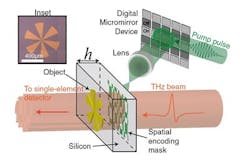Terahertz imaging method aims for faster skin cancer detection
Researchers at the University of Exeter (England) have developed a terahertz imaging approach that can acquire micron-scale images while retaining computational approaches designed to speed up image acquisition. This combination could allow terahertz imaging to be useful for detecting early-stage skin cancer without requiring a tissue biopsy from the patient.
Related: Terahertz reflectometry identifies early skin cancer
Light in the terahertz region is ideal for biological applications because, unlike x-rays, it doesn't carry enough energy to harm tissue. Other research has shown that skin cancer cells absorb terahertz light more strongly than healthy cells, demonstrating that terahertz imaging can be useful for distinguishing between cancerous and healthy tissue.
"Skin cancer can already be detected using terahertz light, but because of the low resolution of current imaging approaches, the cancer can only be seen after it has grown quite large," says Rayko Stantchev of the University of Exeter, who led the work. "Ideally, we want to detect the cancer early, when it is still small. We hope that high-resolution terahertz images, combined with the ability to take an image quickly, could eventually lead to a device that could detect cancer in the doctor's office."
In their study, the researchers showed that their near-field approach to terahertz imaging can achieve a spatial resolution of about 9 µm, and was compatible with compressed sensing and adaptive imaging algorithms that allow 3X faster image acquisition than conventional technologies.
In conventional imaging, spatial resolution is limited by the diffraction limit, which is determined by the wavelength of light used. Although most imaging techniques detect scattered light at some distance from the object being imaged, the researchers overcame the diffraction limit by using a unique setup to measure near-field interactions of terahertz waves with the object being imaged. Their approach produced a resolution about 1/45 of the wavelength used for imaging.
The primary innovation that made the approach possible was a digital micromirror device (DMD), an array of tiny mirrors that can each be controlled by a computer. The researchers use the DMD to project a pattern of 800 nm light onto a silicon wafer, which makes the wafer opaque to terahertz light in areas where the 800 nm light hits the silicon. This means that when a terahertz beam passes though the wafer, it creates a patterned terahertz beam on the other side of the wafer that can then interact with an object being imaged. Because the pattern created by the DMD is known, a computer can reconstruct an image of the object based on the detected terahertz light.
Because near-field terahertz imaging approaches are typically plagued by slow acquisition speeds, the researchers designed their approach to be compatible with compressed sensing and adaptive sampling algorithms that increase the rate of imaging. These algorithms work similarly to image compression, which reduces the size of an image by getting rid of any data not needed to visually perceive an image. Compressed sensing and adaptive imaging algorithms take this a step farther by ignoring the unnecessary data to begin with, speeding up imaging by measuring only the vital components of the image.
"We used these algorithms to determine which regions of the wafer are transparent and which regions are not transparent, essentially creating pixels," Stantchev says. "Because we were using a single-pixel terahertz detector, normally each pixel would acquire one measurement. However, by creating many transparent pixels in one measurement, an image can be acquired more quickly by taking fewer measurements than the number of pixels."
The researchers used their setup to image a variety of objects and showed that the method could distinguish arms of a metallic cartwheel that were spaced about 9 µm apart.
"For our current setup, we have to use a very intense laser to make the silicon wafers opaque," Stantchev says. "This laser is very big and expensive, so to make this approach practical, we needed to figure out how to do it using a much cheaper and smaller laser."
Stantchev is now working with researchers at the Chinese University of Hong Kong, who have created a different optical setup that might be able to make the silicon wafers opaque using a less powerful laser. The researchers are now working together to see if this approach might make it possible to acquire subwavelength terahertz images using a laser that costs around $200 instead of the almost $400,000 laser used for their study.
Full details of the work appear in the journal Optica.
